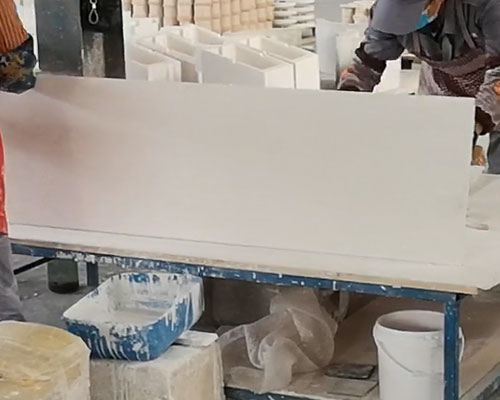Aluminum and aluminum alloys have the characteristics of low density, high strength, good processing performance, and excellent welding performance. They are widely used in the fields of the national economy and national defense and military industries. They are an important lightweight and high-strength structural material. Continuous casting and rolling is one of the most advanced aluminum forming technologies. Compared with traditional casting and rolling methods, it can greatly improve the metal yield and the quality of cast slabs, and save energy. However, the aluminum silicate caster tip is a key component of high-level continuous casting production line equipment.
The aluminum silicate caster tip is a key component to send the aluminum melt into the continuous casting machine. It is a consumable product and is prone to blockage in actual production. Once it is blocked, it must be shut down for cleaning or replacement before production can continue, which greatly reduces production efficiency.
For this reason, some scholars have studied the phenomenon of slag clogging in the caster tip of the continuous casting machine and found that when the impurities in the aluminum alloy melt contact the surface of the nozzle, they will continuously precipitate due to the decrease in temperature.
On the other hand, the morphology and composition of the nozzle material and pure aluminum sheet after reacting at different temperatures for different times are studied through experiments. It is of great practical significance to clarify the cause of casting tips and nozzle blockage and improve the nozzle material and its structure to improve production efficiency.

During the continuous casting process, the molten aluminum will continuously react with the casting tip material to form Al2O3 slag. In the initial stage of production, the surface of the inner wall of the casting nozzle is smooth, and the flow of aluminum liquid is fast, which can continuously wash away the reaction products (Al2O3 and elemental silicon) on the inner wall surface. The alloy formed by Al2O3 and elemental silicon and aluminum thus enters the molten aluminum, and at the same time, the temperature of the molten aluminum in contact with the inner wall of the casting nozzle is relatively low.
These two factors work together to cause the viscosity of the molten aluminum to increase and the flow rate to decrease, thereby reducing the molten aluminum The scouring ability causes more and more slag on the inner wall of the nozzle, and the cavity becomes narrower. In addition, because the nozzle material is a porous material, the reaction between the molten aluminum and the nozzle material not only occurs on the surface, but also inside.
When the reaction products are separated under the scouring action of the molten aluminum, tiny pits will be formed on the surface of the nozzle, and the reaction products are loose and porous, which will increase the surface roughness of the inner wall of the nozzle. The molten aluminum is more likely to solidify on rough surfaces. Therefore, as the continuous casting continues, there are more and more slag inclusions on the inner wall surface of the casting nozzle, and the aluminum liquid channel is constantly narrowing, which eventually causes the aluminum liquid to flow and the casting nozzle is blocked.

